 W
WAbactochromis is a monotypic genus of cichlid fish containing the single species Abactochromis labrosus. The genus name combines the Latin for "driven away from" with the commonly used haplochromine name "chromis". The name encompasses both the origin of the genus and the fish's solitary, wandering behaviour.
 W
WAssessor macneilli, the blue devilfish or blue scissortail, is a fish from the southwest Pacific Ocean. It occasionally makes its way into the aquarium trade. It grows to 6 centimetres (2.4 in) in length. It is purple-blue with long fins.
 W
WThe big-eyed cardinalfish or bigeye cardinalfish is a species of deepwater cardinalfish found in the southern Indian Ocean and southwestern Pacific Ocean from south of Madagascar to New Zealand. This fish occurs at depths from 530 to 820 m. This species can reach 21 centimetres (8.3 in) in total length.
 W
WThe black shinner is a species of cyprinid fish endemic to South Korea. It is also a type species of genus Pseudopungtungia.
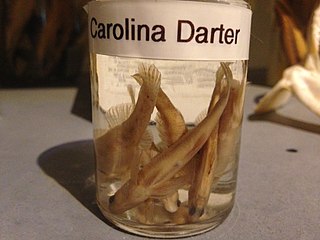 W
WThe Carolina darter is a species of freshwater ray-finned fish, a darter from the subfamily Etheostomatinae, part of the family Percidae, which also contains the perches, ruffes and pikeperches. It is endemic to the eastern United States, where it occurs in the Atlantic Piedmont from Roanoke River drainage of Virginia to Santee River drainage of South Carolina. It inhabits muddy and rocky pools and backwaters of sluggish headwaters and creeks. This species can reach a length of 6 cm (2.4 in). The Carolina darter was first formally described in 1935 as Hololepis collis by the American ichthyologists Carl Leavitt Hubbs (1894-1979) and Mott Dwight Cannon with the type locality given as a creek near York, South Carolina.
 W
WSerranus tortugarum, the chalk bass, is a species of marine ray-finned fish, a sea bass from the subfamily Serraninae, classified as part of the family Serranidae which includes the groupers and anthias. It is found in the western Atlantic Ocean. This species is found in the aquarium trade.
 W
WThe leaping bonito is a species of saltwater finfish from the Scombridae (Mackerel) family. Scombridae includes such tribes as the mackerels, tunas, and bonitos – the latter of which, the Sardini tribe, this fish is a member. It is the only member of the genus Cybiosarda, which is therefore called a monotypic taxon. Since the bonitos and tunas are close relatives, this fish has variously been referred to by such other common names as Australian tuna, striped bonito, and Watson's bonito.
 W
WDrombus halei, Hale's drombus, is a species of ray-finned fish from the family Gobiidae. It is found in the warmer waters of Australia from Shark Bay, Western Australia, to Shoalwater Bay, Queensland. where it occurs around shallow inshore rocky and coral-rock reefs, where there are areas which have sea beds consisting of sand, rubble and sandy-mud, it can also sometimes be found in estuaries and near mangroves. The specific name honours Herbert M. Hale (1895-1963) who was Director of the South Australian Museum.
 W
WThe electric blue hap is a species of cichlid fish endemic to Lake Malawi. It prefers to live in caves and crevices in rocky substrates. This species can reach a length of 20 centimetres (7.9 in) TL. It can also be found in the aquarium trade.
 W
WGobiobotia brevibarba is a species of small freshwater fish in the family Cyprinidae. It is endemic to South Korea.
 W
WGobioclinus dendriticus, the Bravo clinid, is a species of labrisomid blenny native to the Galapagos Islands and Malpelo Island. It inhabits such habitats as undercuts and ledges on rock wall faces, reefs, and areas with many boulders at depths of from 1 to 23 metres though usually no shallower than 6 metres (20 ft) and no deeper than 18 metres (59 ft). This species preys on small fishes and crustaceans. It can reach a length of 13 centimetres (5.1 in) TL.
 W
WThe Hispaniola pupfish is a fish found in Etang Saumâtre and Lake Enriquillo on the island of Hispaniola.
 W
WKribi killi is a species of African killifish that mainly inhabits swamps and turbid parts of brooks in the coastal rainforest. The species is endemic to Cameroon. Adult fish reach a maximum length of approximately 9 centimetres. Breeding pairs of the species most often lay their eggs over the bottom, but occasionally also among the roots of free-floating aquatic plants. Pairs stay close for some time, with just a few eggs being produced each day. It is sometimes kept in captivity but difficult to maintain and breed in an aquarium.
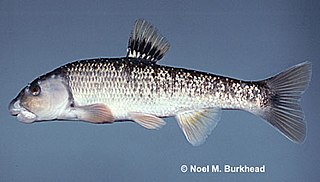 W
WThe largescale stoneroller is a fish in the family Cyprinidae native to the eastern United States.
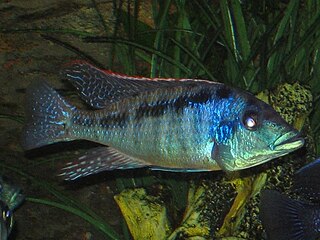 W
WThe Malawi gar is a species of predatory cichlid endemic to Lake Malawi. This species can reach a length of 30 centimetres (12 in) TL. It can also be found in the aquarium trade. It is the only known species in its genus.
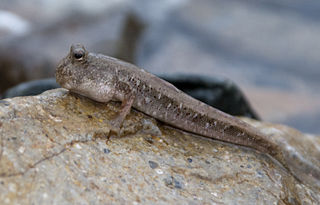 W
WThe New Guinea mudskipper is a species of mudskippers native to fresh and brackish waters along the coasts of Australia and Indonesia. This species occurs in estuaries and tidal creeks as well as mangrove forests and nipa palm stands This species can reach a length of 8 centimetres (3.1 in) SL.
 W
WOtopharynx tetraspilus is a species of cichlid endemic to Lake Malawi where it is only known from the southern end of the lake. This species can reach a length of 15.6 centimetres (6.1 in) TL. It can also be found in the aquarium trade.
 W
WPeckoltia brevis is a small species of Peckoltia belonging to the catfish family Loricariidae. Peckoltia brevis possesses the L-number L205.
 W
WThe pelagic thresher is a species of thresher shark, family Alopiidae; this group of sharks is characterized by the greatly elongated upper lobes of their caudal fins. The pelagic thresher occurs in the tropical and subtropical waters of the Indian and Pacific Oceans, usually far from shore, but occasionally entering coastal habitats. It is often confused with the common thresher, even in professional publications, but can be distinguished by the dark, rather than white, color over the bases of its pectoral fins. The smallest of the three thresher species, the pelagic thresher typically measures 3 m (10 ft) long.
 W
WPlacidochromis phenochilus is a species of cichlid endemic to the northern parts of Lake Malawi. This species can reach a length of 15.7 centimetres (6.2 in) TL.
 W
WProtomelas spilonotus is a species of cichlid endemic to Lake Malawi where it prefers areas with clean, rocky substrates. This species can reach a length of 16.7 centimetres (6.6 in) TL. It can also be found in the aquarium trade.
 W
WProtomelas taeniolatus is a Haplochromine cichlid endemic to Lake Malawi in Eastern Africa. The fish is popular in the aquarium hobby due to the bright rainbow-like colors of adult males and its relatively peaceful temperament. Juvenile and female P. taeniolatus, like many Haplochromines, do not display bright coloration.
 W
WPseudotropheus brevis is a species of cichlid endemic to Lake Malawi where it is found in Nkudzi Bay and Monkey Bay in rocky areas. This species can reach a length of 12 centimetres (4.7 in) SL. It can also be found in the aquarium trade.
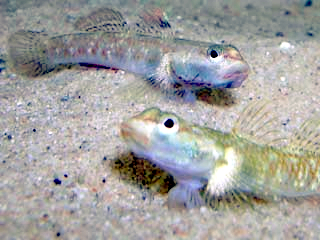 W
WRhinogobius duospilus is a species of goby native to China and Vietnam where they can be found in fresh or brackish waters. This species can reach a length of 4.5 centimetres (1.8 in) TL. In their natural environment these fish consume larvae or other similar creatures, but they can be fed brine shrimp or blood worms.
 W
WRhodeus suigensis is a temperate freshwater fish belonging to the Acheilognathinae subfamily of the family Cyprinidae. It originated in inland rivers in Japan and the Korean peninsula. It was originally described as Pseudoperilampus suigensis by T. Mori in 1935, and has also been referred to as Rhodeus atremius suigensis in scientific literature. The species was listed as endangered in 1994 by the World Conservation Monitoring Centre, but in 1996 was relisted as "data deficient". When spawning, the females deposit their eggs inside bivalves, where they hatch and the young remain until they can swim.
 W
WRhodeus uyekii is a temperate freshwater fish belonging to the Acheilognathinae sub-family of the family Cyprinidae. It originates in inland rivers in South Korea. It was originally described as Pseudoperilampus uyekii by T. Mori in 1935. The fish reaches a length up to 6.0 cm (2.4 in). When spawning, the females deposit their eggs inside bivalves, where they hatch and the young remain until they can swim.
 W
WThe shortjaw lizardfish is a species of lizardfish that lives mainly in tropical waters.
 W
WThe silver-banded whiting, Sillago argentifasciata, is a narrowly distributed species of inshore marine fish of the smelt whiting family Sillaginidae that inhabits the coastline of a single province within the Philippines. The species' taxonomic status is still marginally uncertain, with the last major review of sillaginid fish by McKay proposing S. argentifasciata is a senior synonym of a related species, S. ingenuua. The species takes its name from a brilliant silvery strip running laterally across its body.
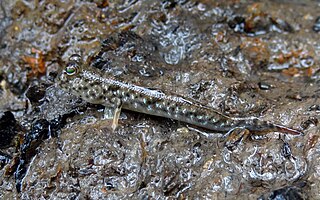 W
WThe slender mudskipper is a species of mudskippers native to marine and brackish waters of the eastern Indian Ocean and the western Pacific Ocean where it is an inhabitant of the intertidal zone, capable of spending time out of water. This species can reach a length of 4.5 centimetres (1.8 in) SL.
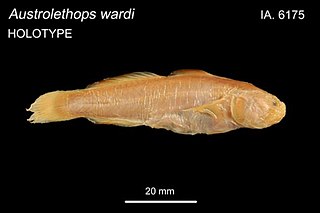 W
WThe small-eyed goby is a species of goby native to tropical reefs of the Indian Ocean through the western Pacific Ocean where it inhabits areas of coral rubble. As its common name suggests, this species has particularly small eyes. This species grows to a length of 6 centimetres (2.4 in) TL. This species is the only known member of its genus. The small-eyed goby is specialised to feed on seagrass and they share a burrows with mud lobsters of the genus Thalassina. The specific name honours Charles Melbourne Ward (1903-1966), the Australian actor, naturalist and collector of specimens who collected the type specimen.
 W
WSynodontis thamalakanensis is a species of upside-down catfish native to Botswana and Namibia. This species grows to a length of 17.5 centimetres (6.9 in) SL.
 W
WTaeniacara candidi is a species of cichlid fish from the Amazon Basin in South America. This species is considered a dwarf cichlid in which reaches a length of 5 centimetres (2.0 in) TL. This species can also be found in the aquarium trade, but requires very soft, acidic water and is known for being unexpectedly aggressive for a fish its size; a male will usually kill any other males in a tank shorter than 4 feet in length.
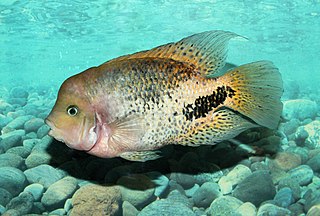 W
WVieja melanura, the quetzal cichlid, redhead cichlid or firehead cichlid, is a species of cichlid native to Central America where it occurs in the Usumacinta River drainage in the countries of Mexico, Belize and Guatemala. This species can reach a length of 35 centimetres (14 in) TL. It is also popular in the aquarium trade.